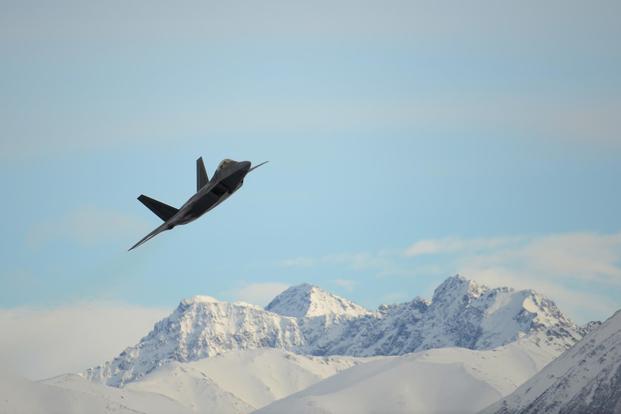The U.S. Air Force is investigating what caused two F-22 Raptors from the same Joint Base Elmendorf-Richardson, Alaska, unit to experience mishaps within days of each other.
An F-22 from the 90th Fighter Squadron, 3rd Wing, experienced engine failure April 6 during a routine training flight at Tyndall Air Force Base, Florida, days before another F-22's belly skid at Naval Air Station Fallon, Nevada, Air Force officials told Military.com on Friday.
"We can confirm that a 3 WG F-22, assigned to the 90th Fighter Squadron, recently experienced an in-flight engine failure while operating out of Tyndall. The aircraft was able to land safely," said 2nd Lt. Brigitte Brantley, a public affairs officer for the 673rd Air Base Wing. The Drive website first reported the engine failure last week.
Brantley said the pilot in the Tyndall accident was unhurt and able to land the twin-engine stealth fighter "without further incident."
No other aircraft were damaged during the landing.
Related content:
- Air Force Launches Aviation Inquiry Amid Reports of Increased Mishaps
- F-22 Ends Up in Belly Skid After Takeoff Mishap at Fallon
- Did the Air Force Dash Hopes for Building More F-22s?
"The aircraft was participating in regularly scheduled training at Tyndall, executing typical training maneuvers when the failure occurred," she said.
The F-22 remains at Tyndall while officials conduct a safety investigation board report, Brantley said.
Days after that engine failure, another fifth-generation fighter went sliding down the runway April 13 following a takeoff at NAS Fallon. The F-22 skidded to a stop, damaging the front end of the aircraft.
Whether the two incidents are related has not been determined, Brantley said.
"Each aircraft mishap is under investigation, and no determinations have been made at this time," she said. "A full incident report will be published for each when the investigation is complete."
Incidents continue to mount as the Air Force has said it remains committed to scrutinizing aviation hazards. The service recently launched an investigation into an increase of "Class C" mishaps to understand whether the lower-grade incidents are leading to fatal accidents.
"We've got our safety professionals digging into it, and seeing if there is a noticeable trend that we have in our Class C mishaps," Vice Chief of Staff Gen. Stephen "Seve" Wilson said April 9 during the Future of War conference.
The latest incident underscores a recent uptick in aviation mishaps across the U.S. military. A recent in-depth Military Times report found that military aviation accidents have increased significantly over the last five years across all services.
-- Oriana Pawlyk can be reached at oriana.pawlyk@military.com. Follow her on Twitter at @Oriana0214.









